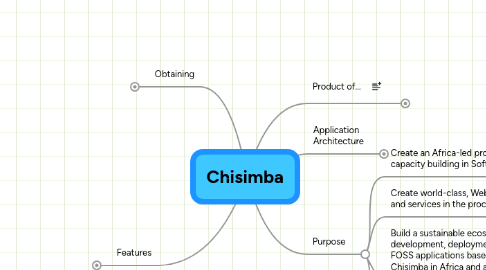
1. Features
1.1. Content Tools
1.1.1. Content Management System
1.1.2. Wiki
1.1.2.1. Use Wiki content in any other content tool and manage it from the Wiki
1.1.2.1.1. e.g. Bliki
1.1.2.1.2. Using filters
1.1.3. Presentation sharing
1.1.4. Filters
1.1.4.1. Content mashup
1.1.4.2. Types
1.1.4.2.1. Internal content
1.1.4.2.2. External content
1.2. Communication Tools
1.2.1. Asynchronous
1.2.1.1. Internal Email
1.2.1.2. Blog
1.2.1.3. Discussion Forum
1.2.2. Synchronous
1.2.2.1. Chat
1.2.2.2. Instant Messaging
1.2.2.3. Realtime meeting rooms
1.2.2.3.1. Voice
1.2.2.3.2. Video
1.2.2.3.3. Whiteboard
1.2.2.3.4. Back-channel Chat
1.2.2.3.5. Presentation
1.3. E-Learning tools
1.3.1. See also Content and Communication Tools
1.3.2. Course designer
1.3.3. Course content
1.3.4. Problem Based Learning
1.3.5. Assessment
1.3.5.1. Multiple Choice Quiz
1.3.5.2. Online Worksheets
1.3.5.3. Assignment management
1.3.5.4. Essay management
1.3.5.5. Rubrics
2. Obtaining
2.1. Obtain Chisimba via the AVOIR website
2.1.1. Software
2.1.2. Documentation
3. Product of...
3.1. African Virtual Open Initiatives and Resources (AVOIR)
3.1.1. Purpose
3.1.1.1. Capacity building in Software Engineering
3.1.1.1.1. in Africa
3.1.1.1.2. Free and Open Source Software (FOSS)
3.1.1.2. Develop sustainable ecosystem supporting developement, deployment and support of FOSS products
3.1.1.3. Africa-led
3.1.2. Network members
3.1.2.1. Africa
3.1.2.1.1. South Africa
3.1.2.1.2. Senegal
3.1.2.1.3. Nigeria
3.1.2.1.4. Ghana
3.1.2.1.5. Rwanda
3.1.2.1.6. Uganda
3.1.2.1.7. Kenya
3.1.2.1.8. Tanzania
3.1.2.1.9. Mozambique
3.1.2.2. US partners
3.1.2.2.1. Washington State University
3.1.2.3. Other partners
3.1.2.3.1. Afghanistan
3.1.2.4. Collaborative projects
3.1.3. Funding partners
3.1.3.1. Canada
3.1.3.1.1. International Development Research Centre (IDRC)
3.1.3.2. USA
3.1.3.2.1. US Agency for International Development (USAID)
3.1.3.3. Private sector
3.1.3.3.1. Sun Microsystems
3.2. Free Software Innovation Unit at the University of the Western Cape (UWC)
4. Purpose
4.1. Create an Africa-led project to facilitate capacity building in Software Engineering
4.2. Create world-class, Web 2.0 enabled software and services in the process of capacity building
4.3. Build a sustainable ecosystem for the development, deployment and support of FOSS applications based primarily around Chisimba in Africa and around the world
4.4. Create the building blocks for solid and robust web and distributed applications for E-Learning, enterprise applications, and build the capacity to deploy and support them
5. Application Architecture
5.1. Model-View-Controller architectural pattern
5.2. Modular impementation
5.3. Front controller
5.4. Bridge to other applications
5.5. Package Management
5.5.1. Manage installations in a web browser Graphical User Interface
5.5.2. Online package installation and updates via our package management server
5.5.2.1. Download and install entire system types with a single click
5.5.2.1.1. examples
5.5.2.2. Download and install modules with their dependencies via a single click
5.5.2.3. Carry out dynamic upgrades to modules as they become available on the package server
5.5.2.4. Provide the easiest management of your packages you will find in any system
5.5.2.4.1. Concept similar to Debian package management
5.6. Scalability
5.6.1. Built-in support for memcached, allows for infinite scalability
5.6.1.1. Object level caching for maximum scalability
5.6.1.2. Support for multiple MemcacheD instances
5.6.2. Support for database clustering
5.6.3. Support for load balancing via round-robin DNS
5.6.4. Internal Caching via APC
5.6.4.1. Core module code
5.6.4.2. Frequently accessed data
5.6.5. LVS - Linux Virtual Server clustering
